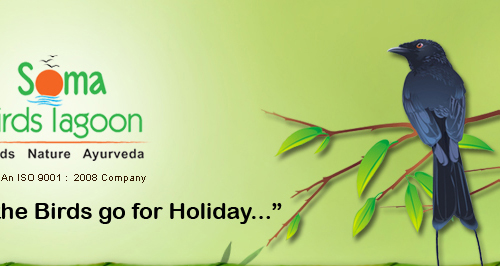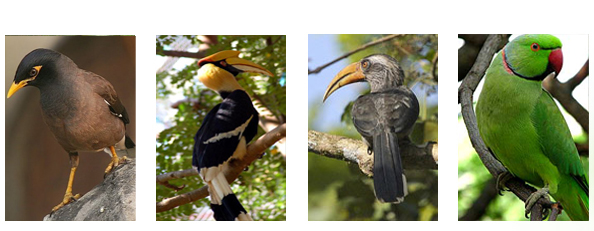




21. Common Hoopoe (Upupa epops)

Hoopoe is a medium sized bird which can be identified at once by the conspicuous fan like crest and distinctive black and white markings in the wing coverts and a white middle band in its tail. Its body is light yellowish brown and have a slender long bill. Crest feathers have black tip. Its call is a soft musical hoo-po-po. They are often seen in lightly wooded regions and avoid thick forests. Breeding season is from February to May. Local name is Uppooppan
22. Stork Billed Kingfisher (Halcyon capensis)

These birds can be easily distinguished from other kingfishers by its large body size and its huge red bill. They have grayish brown head and greenish blue upper parts. Under parts are pale yellow brown and have a buff collar. Legs are bright red. Their call is a high pitched laugh ke-ke-ke-ke-ke-ke. They feed mainly on fish , frog and crab. Local name is Kakka ponman.

They are also called White Breasted Kingfisher. They have turquoise blue upper parts and dark brown head , nape and flank.. Under parts are mostly brown with a white neck and centre of the breast. In flight a white patch is seen on the wings.They are commonly found in various water bodies.Their call is a loud ke-ke-kek-kek-kek . Local name is Ponman

They are common birds found throughout India. They have short body with a stumpy tail and large head with strong beaks. Adults have greenish blue head,scapulae and wings are covert orange. Their under parts are rufous and have a green-blue neck stripe and a white neck patch.Local name is Podi ponman.

A tiny bird brilliantly colored with purplish blue on the mantle and bluish black upper wing coverts.Their under parts are yellow and the beak is light pinkish-orange. It prefers small streams inside evergreen forests which make its sighting bit difficult. A recent sighting has been reported from the Thattekkad Sanctuary. Local name is Meni ponman.

Indian Cormorants are also called Indian Shag. They are slightly larger than the Little Cormorant and can be easily distinguished by its thin neck and long narrow beak. Breeding adults have black body with white tuft near the eyes and white plumes on the neck . Non breeding birds are brownish black with whitish throat. Local name is Kinnari Neerkakka.

Rufous Treepie is a member of the Corvidae family found throughout India. Its vernacular name is Olen njaali. It prefers open forests and is well adapted to live in urban areas. Its body is Cinnamon colored and have black head and legs. White patches are seen on the wings and have tawny brown underside with a long bluish grey tail with a black patch at its tip. It usually travel alongside with unrelated species like Drongos and Babblers. The breeding season in India is April to June.

As its name suggests White bellied treepie can be easily distinguished from the Rufous treepie with its white colored head and body. Its endemic to the hills of South India. Unlike Rufous Treepie it avoids urban areas and are found in the dense forests. Its local name is Kaatu Njali. Its main diet includes fruits, insects and worms.

House Crows are the most common birds in India. They are well adapted to live in cities and other urban areas as they show no fear for humans. Its forehead, wings, legs and tail are glossy black whereas breast and neck are light grayish brown. They are omnivorous and feed almost anything that is edible. These birds can be seen in market places and garbage areas. Their voice is a harsh Kaa – kaa hence getting the local name kakka

Jungle Crows are also widespread and common as the House Crow.They are slightly larger in size with glossy black forehead, wings and tails. Its neck and breast are dark grey in colour. Eleven sub species are also found in the Sub-Continent. Their diet includes a wide range of items, eating almost everything edible. Their vernacular names are Tonnan kakka or Beli kakka.
1 2 3 4 5 6 7 8 9






© 2010 Somatheeram Ayurveda Group. All rights reserved. Website designed by CyberSoma.